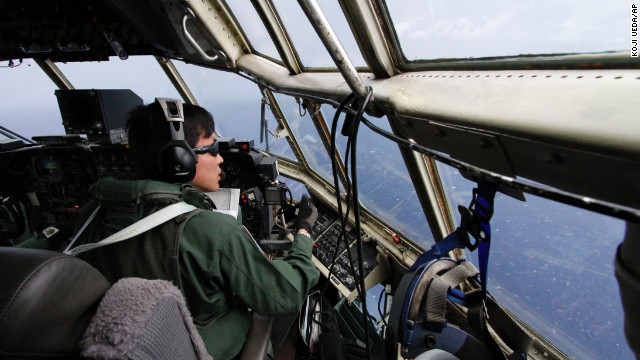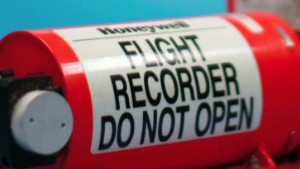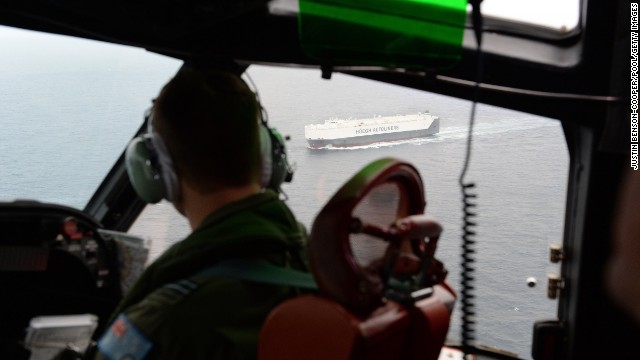From 'ghostly' to psychic, theories abound on Malaysia Airlines Flight 370
March 22, 2014 -- Updated 0250 GMT (1050 HKT)

Here are the theories surrounding MH370
Conjecture by experts now ranges from the other-worldly to the generic.
It's been two weeks since the plane disappeared after a March 8 takeoff from Kuala Lumpur, heading to Beijing.
Theory: Ghost or zombie plane
The newest -- and most
provocative -- speculation centers on the so-called "zombie theory"
advanced most notably by aviation specialist Clive Irving of The Daily Beast.
 Quest: 'Very poor translation'
Quest: 'Very poor translation'
 Could data recorder turn up 'blank box?'
Could data recorder turn up 'blank box?'
 Bill Nye: We will find Flight 370
Bill Nye: We will find Flight 370
 Photos: The search for Malaysia Airlines Flight 370
Photos: The search for Malaysia Airlines Flight 370
Other experts, however,
dislike his choice of words: "I really don't like the term 'zombie
plane.' That connotes a sinister aspect to it. But, I'd prefer it to
call it a ghost plane. But, we have seen things like this before," said
William Waldock, a professor at U.S.-based Embry-Riddle Aeronautical
University.
A ghost plane is one
where everyone aboard -- pilots, crew, passengers -- loses consciousness
because of a loss of pressurization, an explosion, smoke or fumes,
experts say.
Under this supposition,
the Malaysia plane experienced such an incident and, with everyone
knocked out, continued to fly for hours on autopilot until the aircraft
ran out of fuel.
It's not a fantasy. Such
ghost-plane events occur, though rarely. For example, in 1999, a
chartered Lear jet carrying professional golfer Payne Stewart and four
others crashed in a South Dakota field after it flew on its own for four
hours. That's because all aboard were dead after the cabin lost
pressure -- with windows frosted over. Not even jet fighters shadowing
the plane could stop it from running out of fuel and crashing.
"I think in the first
few minutes of this emergency, the pilots had to change course because
they were looking for an emergency airport," Irving said about the
Malaysian flight. "They were at some point overtaken by whatever it was,
smoke, fire, or some kind of problem. And the plane was then left to
fly itself after it had been programmed to go on that course. That's
what we call a zombie option."
CNN aviation analyst Les
Abend considers the thesis "very viable." Abend has flown the Boeing
777, the same kind of aircraft used for Flight 370.
"It can happen instantly
if it's an explosive situation," Abend said. "It can happen insidiously
if it's a slow situation. But my scenario is a smoldering fire that
created smoke and once that smoke began the crew donned their oxygen
masks. The unfortunate part is you can't totally see a lot of all that
smoke from breathing and you're going to get some toxic fumes, depending
upon what is burning."
Sensing a problem in the
offing, the plane's captain may have "realized it was compelling enough
to get the airplane turned and entered a waypoint that was an alternate
airport in the flight management computer and kept the autopilot
connected because this plane is designed, especially in an emergency
situation to reduce workload," Abend said.
"It sounds rather
ominous to call it a zombie operation owr a ghost ship, but in a way it
is very ominous. As it progressed towards the waypoint, the toxic fumes
perhaps overcame the crew and perhaps the passengers and at some point,
they were no longer able to function," Abend said.
Other experts took exception, however.
"There's a lot of holes in that story. It's a very popular theory," said private pilot and aviation writer Jeff Wise.
If the pilot did turn
the plane while under distress, then "you don't wind up southwest of
Australia, you wind up in Africa," Wise said.
Miles O'Brien, another CNN aviation analyst and a former CNN correspondent, said he found the theory incredulous.
"To create this whole
scenario where the plane is a zombie and they can't get a radio call off
to say, 'We're in trouble here because we've got a fire burning,' I
just find that a little bit hard to believe. They had good radio
contact," O'Brien said. "You look at previous crashes where there have
been fires or smoldering fires, and the crew is talking back and forth
to air traffic control for quite a bit."
Theory: Incapacitated crew
The crew may have become
incapacitated to fly the plane -- for whatever reason -- and unable to
land the plane, said former pilot Alastair Rosenschein.
This theory focuses
solely on the crew and assumes the plane may have crashed in the south
Indian Ocean where sea and air searches are now taking place.
Under this concept, with
the crew incapacitated none of the passengers would have the ability to
take control of the plane or issue a distress call by radio. All or
some may have been incapacitated -- or not -- as well.
"Let's be very clear
about this: The aircraft would not have been in that location had the
pilots had control of the aircraft, had they been conscious and had they
had the desire to save their lives and land somewhere," Rosenschein
said. "So I would go on the premise that if the aircraft went down
there, it was uncontrolled and ran out of fuel."
The location of the
southern Indian Ocean would match the Boeing 777's maximum fuel range
provide by investigators, said Robert Goyer, editor-in-chief of Flying
magazine and a commercial jet-rated pilot.
"While there are a small
number of possible scenarios at play here, the most likely, it seems to
me, is that the airplane was flying on autopilot without anyone at the
controls and did so until it ran out of fuel and crashed into the
ocean," Goyer said in a CNN Opinion column.
"The autopilot almost certainly would have remained working even after
the plane ran out of fuel, though the dynamics of such a crash scenario
are complex."
If the plane ran out of
fuel while on autopilot, as in the ghost plane theory, the landing at
sea would have the same path as one on land, said Mitchell Casado, a
Boeing 777 pilot trainer.
"It's not going to be
any dramatic nose down or turning or anything like that. It's just going
to be a very gentle, gradual decent -- very similar, actually, to what
you would experience in a regular flight," Casado said. "Just a very
gradual decent but constant until you hit the ground."
If so, wreckage could be more easily recovered at sea, said aviation expert Ronald Carr.
"If it glides down and
stuff, it's going to be less steep hitting the water, in which case it
might stay more intact or it might be more pieces available to search
for the debris pattern," Carr said. "If it comes down at a very steep
angle like -- well, the one I'm thinking of is the Payne Stewart
situation where the airplane was on auto pilot, ran out of fuel and then
nosed over and came down pretty steep, and so there wasn't much
aircraft left of that situation."
Theory: Terrorism
Experts haven't ruled out terrorism.
"You know there are some
suggestion that it could (be terrorism), but that's a long way away
from saying that there's any kind of evidence that it did," Flaying
magazine editor Goyer said.
Malaysian military radar
registered dramatic altitude changes for Flight 370 -- rising to 45,000
feet and then descending to 23,000 feet -- and an erratic path as it
moved across Malaysia in what are some of the last known readings of the
plane's location, according to a senior U.S. official.
The official, who is
familiar with analysis of that radar data and declined to be identified
because of the sensitive nature of the information, cautioned that this
assessment is not definitive. The readings are not believed entirely
accurate due to the distance the plane was operating from the radars
that detected it, according to the official.
Still, analysts surmise possible causes for the altitude changes.
"Some of the flight
profile changes might suggest that the flight was commandeered," Goyer
said. "Was it by one of the pilots or by an intruder? It would be more
likely that it was ... by one of the pilots. But, again, there's no
evidence for that either way. The altitude changes that we saw could
have suggested a struggle for the controls, if those reports are really
accurate. And at this point, we don't really know how good that radar
data is."
Theory: Pilot heroism or suicide? Or "barratry"?
Inevitably, public
attention turns to the plane's captaining and whether the pilot and
co-pilot deliberately tried to destroy the aircraft -- or save it from
peril.
Among the disturbing
circumstances of the plane's disappearance is how its transponder and
communication systems were off shortly after takeoff.
Some experts postulate
those systems failed because of fire, and the pilots pulled the main
buses -- conductors carrying a computer system's data and control
signals -- to "restore circuits one by one until you have isolated the
bad one," pilot Chris Goodfellow said in Wired Magazine.
If the buses were
pulled, "the plane would go silent. It probably was a serious event and
the flight crew was occupied with controlling the plane and trying to
fight the fire. Aviate, navigate, and lastly, communicate is the mantra
in such situations," Goodfellow said.
He said radar reports
that the plane ascended to 45,000 feet were unreliable. And, even if
true, they are not necessarily damning. The pilot might have been
seeking to quell the fire by going to an altitude with less oxygen, he
said.
A reported rapid descent
could have resulted from a stall at such a height, above the plane's
limit, followed by a recovery at 25,000 feet. "The pilot may even have
been diving to extinguish flames," he said. "But going to 45,000 feet in
a hijack scenario doesn't make any good sense to me."
Other experts have
advanced the possibility of the pilot -- or crew -- bent on annihilation
of self and everyone aboard the plane.
For example, EgyptAir
Flight 990 was flying 217 people from Los Angeles to New York to Cairo
in 1999 when it crashed into the Atlantic Ocean. U.S. officials blamed a
co-pilot, who was recorded repeating a prayer, for deliberately causing
the crash, but Egyptian officials blamed mechanical problems.
"It's my belief that
there was probably some type of struggle in the cockpit where it was one
of the pilots that maybe had a meltdown or did something nefarious to
the airplane," said Mark Weiss, a retired American Airlines pilot
captain who has flown the Boeing 777 and now works at the Washington
consulting firm Spectrum Group.
Wise invoked a maritime legal term in describing possibly sinister acts by crew or pilots.
"I'm going to throw in a
word here that hasn't been used very much and I think it's important to
use it because are we calling it hijacking? Are we calling it sabotage?
Are we calling it some kind of mutiny? The world in maritime law is
barratry," Wise said. "Barratry is when the captain of a vessel
commandeers it to sink it or to cause it harm. I think that's maybe what
we're talking about here."
Theories: The bizarre
Unconstrained by the
professional accountability under which the experts labor, some Internet
users have ventured into the realms of the bizarre and paranormal --
which serve to show how the plane's disappearance captivates the world's
imagination, for better or for worse.
Some assert a meteor
struck the plane because one was reported in the area around the time
Flight 370 took off. But given what little is known about the flight
path, and the astronomical odds against such an event, a meteor strike
seems like an ultra-long-shot explanation.
Some claim the plane landed on an airstrip without anyone noticing.
"What I have failed to
read so far is the possibility that the pilot in command intentionally
turned off the engines and performed a dead-stick landing at their
intended destination," CNN.com reader Dave Mathews said in an e-mail.
"Planes are essentially gliders with power and a 777 is no different, it
is simply a big glider which makes zero noise with no power."
He cited the story of
the so-called Gimli Glider, an Air Canada Boeing 767 whose captain
glided it to safety at small Gimli airport when it ran out of fuel and
lost power during a flight in 1983.
Lisa Williams, a psychic
in California, said she believed the plane went down somewhere but with
passengers still alive, though she doesn't have proof.
"Well, naturally, I
don't actually have hard concrete evidence. And I think any psychic who
has hard concrete evidence can't do their job correctly because they get
misinformed," Williams said.
"I do believe that it
actually crashed and I see a lot of trees. I didn`t specifically look
into this for a reason, because I`m actually reading for some of the
families' friends," Williams said on HLN.
"I kept feeling as
though, yes, there are some people that have passed away because it's
only natural after these amount of days someone is going to cross with
no food, no water, but I also believe there was a hijacking," she said.
But CNN analyst Abend dismissed Williams' speculation as wild.
"With no disparaging
Lisa's profession, I mean, listen, I'm an airline pilot. I deal in black
and white," Abend said. "It's difficult for me to, in this particular
circumstance, to think that a psychic could solve a problem that people
all over the world are not able to solve at this point."
CNN's Tom Watkins and Matt Smith contributed to this report.
--------------------------------------------------------

ไม่มีความคิดเห็น:
แสดงความคิดเห็น